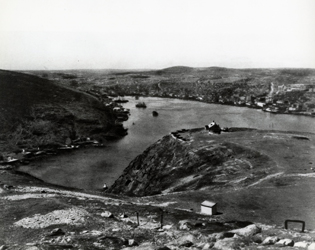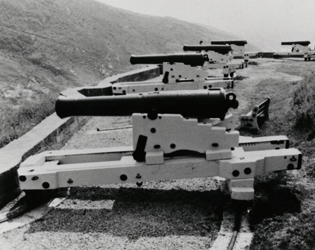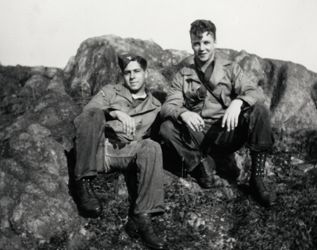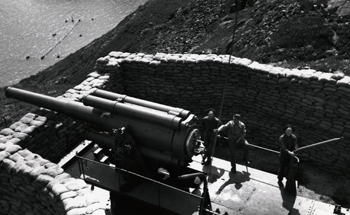
Defence of the narrows
Signal Hill National Historic Site
Along with the south side of the Narrows, Signal Hill was an integral part of the defence systems of St. John’s from the 1660s to the Second World War, playing an important role in the defence history of Canada.
 View of the Queen's Battery from the summit of Signal Hill
View of the Queen's Battery from the summit of Signal Hill1600s
Newfoundland was home to historically vast resources of codfish in the waters just off its coast which drew migratory fishers from many European nations.
Shore batteries built on either side of the Narrows (including Signal Hill) were the first known defences of St. John’s Harbour, protecting the city against naval attack.
1700s
Signal Hill saw its share of military action during this time period. British St. John’s fell to the French several times between 1696 and 1709. In 1713, the Treaty of Utrecht recognized British sovereignty over Newfoundland, which put a temporary end to the British and French conflict in the area. However near the end of the 1700’s the site saw another French attempt to capture.
The Battle of Signal Hill
 Ladies' Lookout is the highest point of land on Signal Hill and was the location of this historic battle.
Ladies' Lookout is the highest point of land on Signal Hill and was the location of this historic battle.In 1762, French naval captain Charles-Henri-Louis d’Arsac de Ternay was tasked to capture St. John’s, Newfoundland. On June 24th, de Ternay landed in Bay Bulls, and an infantry led by Colonel Joseph-Louis-Bernard de Cleron, compte D’Haussonville marched to St. John’s. Captain Walter Ross, British Commanding Officer of the St. John’s garrison, miscalculated the number of French army and surrendered without firing a shot. Artillery was then set up around St. John’s, including several pieces on Signal Hill, in anticipation of a counterattack by the British.
On September 15th, 1762 Lieutenant-Colonel William Amherst advanced British troops overland from the nearby settlement of Torbay to take Signal Hill from the French. This would provide a strategic advantage over the French for taking the rest of the city of St. John’s. Following two small skirmages, Amherst’s men set up a field hospital in Quidi Vidi and prepared for an attack on Signal Hill. Under the leadership of Captain Charles McDonell, two companies of light infantry advanced up the hill in single file at the break of dawn in heavy fog. The French artillery, led by Lieutenant-Colonel Bellecomb, was caught by complete surprise. The battle was brief and the casualties light, however gruesome, at times resorting to hand to hand combat. The French retreated to nearby Fort William, which was soon taken by Amherst’s men also.
This action was the last battle in the North American theatre of the Seven Years’ War-–a global war spanning five continents fought between 1756-1763 and involving all 5 of the European great powers of the era - and lead to the signing of the Treaty of Paris in 1763.
During 1796-97 the Queen’s Battery was constructed with eleven guns mounted, in addition to a guardhouse which was built directly behind the guns. This guardhouse was home to two men of the Royal Artillery and their families.
1800s
 Two soldiers at Signal Hill circa. 1809. Painting by Ron Pelley (1990)
Two soldiers at Signal Hill circa. 1809. Painting by Ron Pelley (1990)New barracks were built at the Queen’s Battery and the summit in the 1830s and the hill was fortified again during the American Civil War.
During 1832 - 1833, a new masonry barracks was constructed at the Queen’s Battery. During this period, the Royal Newfoundland Companies, formally known as the Royal Veteran Companies, arrived in St. John’s and remained stationed there until 1862. The Royal Newfoundland Companies was eventually absorbed into the Royal Canadian Rifle Regiment, and the Royal Artillery arrived on the hill. The Companies were mostly comprised of former servicemen who were often injured. As guard duty was common, several attempts were initiated to house the Royal Newfoundland Companies at the barracks on Signal Hill.
 There are 6 reproduction 32-pound guns still located at the Queen's Battery Barracks today.
There are 6 reproduction 32-pound guns still located at the Queen's Battery Barracks today.With tensions growing within America, the British military feared the American Civil War would extend into British North America and sent 11,175 troops across the Atlantic Ocean, one destination being Signal Hill. During this period, Queens Battery was equipped with six 32-pound cannons while the barracks was able to hold 13 members of the Royal Artillery, with one Non-Commissioned Officer. During the summer months, the officers’ quarters were equipped to accommodate 3-4 additional troops.
The threat of the American Civil War spilling into the region did not materialize, marking the last time in the nineteenth century that British forces mobilized the area for defence. Over the next couple of decades British Military resources, including those on Signal Hill, were withdrawn from Newfoundland as the British Government reduced their oversees defence commitments shifting this responsibility to the colonies.
1900s
The First World War
In 1916, during the First World War, a log boom was erected across the narrows of St. John’s Harbour to stop German torpedoes. Since many of the local naval reservists were patrolling the coastline to protect fishing vessels off the Grand Banks, a contingent of the Newfoundland Legion of Frontiersmen manned Fort Waldegrave in the Narrows.

The Second World War
On 4 February 1941, Americans officially garrisoned Signal Hill with the exception of Cabot Tower and George’s Pond. This was known as Signal Hill Battery which was an auxiliary station of Fort Pepperrell in St. John’s. Throughout the month of February, a four gun mobile coast defence battery had been created along both the southern and eastern faces of Ladies’ Lookout.
On 1 April 1941, an area on the north side of George’s Pond on the hill was established for an air defence battery where four 3-in. anti-aircraft guns were placed. To further the aviation technology on the hill, the Americans operated an aircraft recognition station about 550 metres from Cabot Tower on 1 February 1942.

There were several temporary frame buildings on Signal Hill which were occupied by the Americans, including eighteen barracks which housed 478 men, two mess halls, two recreation buildings, a tennis court, machine and carpenter shop, dispensary and post exchange, sewage and refrigeration plants, as well as a pump house which took water from George’s Pond. The remains of the Americans presence on site is very limited in the present day with the exception of two Armco steel ammunition huts, known as Quonset Huts which are located on Burma Road.
In late 1943 to early 1944, Burma Road was established as an alternate route between Fort Pepperell and Signal Hill.
The end of the Second World War marked the end of military presence on Signal Hill.
Related links
- Date modified :